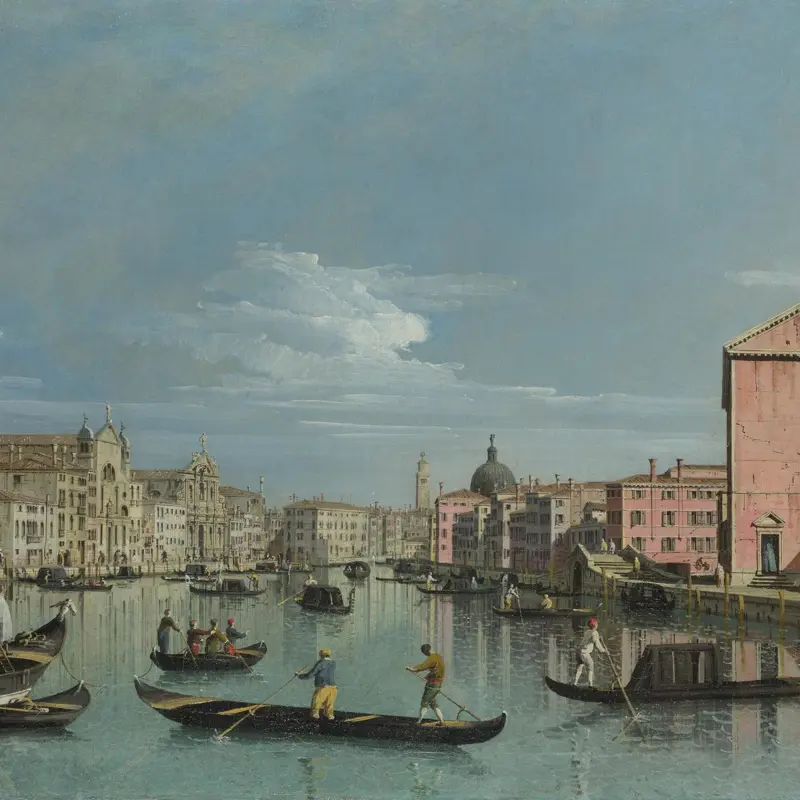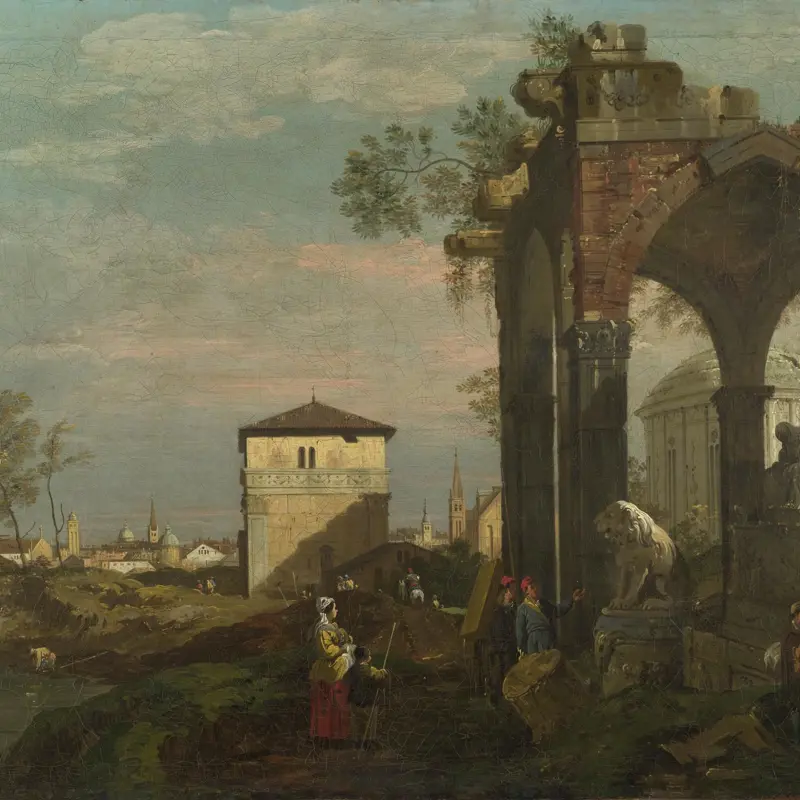Bernardo Bellotto, 'The Fortress of Königstein from the North', 1756-8
About the work
Overview
Sharp and angular, the Saxon fortress of Königstein, about 25 miles southeast of Dresden, is silhouetted against a pale sky. The artist, Bellotto, was from Venice, and he has applied the traditions of Venetian view painting – a high level of detail, the large scale – to this northern landscape. It is one of the five views of Königstein commissioned from Bellotto by King Augustus III of Poland in 1756.
Bellotto has treated the crumbling stone walls with miniaturist precision: each window and scaffolding pole is highlighted, and soldiers, created with just a few dots of paint, stand guard on the ramparts. This minute observation is combined with a broad panorama. Soft sunlight picks out the men in a grassy glade and a woman with her children while, a little higher, a slice of intense light illuminates the livestock perched on a craggy ledge and a horseman descending into the valley beyond.
Key facts
Details
- Full title
- The Fortress of Königstein from the North
- Artist
- Bernardo Bellotto
- Artist dates
- 1722 - 1780
- Date made
- 1756-8
- Medium and support
- oil on canvas
- Dimensions
- 132.1 × 236.2 cm
- Acquisition credit
- Bought with the support of the American Friends of the National Gallery, the National Gallery Trust, the Estate of Mrs Madeline Swallow, Art Fund (with a contribution from The Wolfson Foundation), Howard and Roberta Ahmanson, The Deborah Loeb Brice Foundation, Mrs Mollie W. Vickers, The Manny and Brigitta Davidson Charitable Foundation and The Sackler Trust, with additional support from Mrs Charles Wrightsman, Jean-Luc Baroni, The Linbury Trust, The Monument Trust, Mr Fabrizio Moretti, Sir Hugh and Lady Stevenson, The John S. Cohen Foundation, Mr Jonathan Green, Christoph and Katrin Henkel, Ernst Nissl, Mr Peter Scott CBE QC, Mr and Mrs Ugo Pierucci, Sir Michael and Lady Heller, Mr Adrian Sassoon, Mr Mark Storey, Mr Neil Westreich, Nicholas and Judith Goodison, John and Flavia Ormond and other donors including those who wish to remain anonymous, 2017
- Inventory number
- NG6668
- Location
- Room 37
- Collection
- Main Collection
- Frame
- 19th-century English Frame
Provenance
Additional information
Text extracted from the National Gallery’s Annual Report, ‘The National Gallery: Review of the Year, April 2017 – March 2018’.
Exhibition history
-
2020Castles: Paintings from the National Gallery, LondonAmgueddfa Cymru — National Museum Wales28 January 2020 - 10 May 2020Sunderland Museum and Winter Gardens5 September 2020 - 15 November 2020Norwich Castle Museum & Art Gallery17 May 2021 - 4 July 2021
-
2021Bellotto: The Königstein Views ReunitedThe National Gallery (London)22 July 2021 - 31 October 2021Manchester Art Gallery20 November 2021 - 27 February 2022
-
2022Bernardo Bellotto 300Staatliche Kunstsammlungen Dresden20 May 2022 - 28 August 2022The Royal Castle in Warsaw - Museum23 September 2022 - 8 January 2023
Bibliography
-
2018National Gallery, The National Gallery: Review of the Year, April 2017 - March 2018, London 2018
About this record
If you know more about this work or have spotted an error, please contact us. Please note that exhibition histories are listed from 2009 onwards. Bibliographies may not be complete; more comprehensive information is available in the National Gallery Library.


